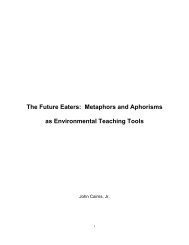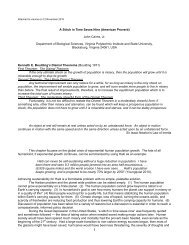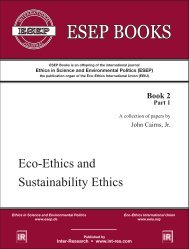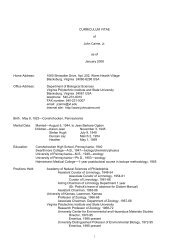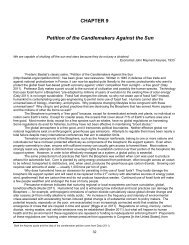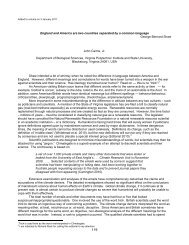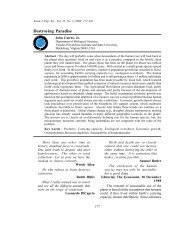You also want an ePaper? Increase the reach of your titles
YUMPU automatically turns print PDFs into web optimized ePapers that Google loves.
Companionate Love<br />
Jeannie and I were married on August 5, 1944, just after Jeannie acquired a BS in biochemistry and while I was in<br />
the US Navy. For the part of our marriage after World War II, I had to spend about 1½ years completing my AB at<br />
Swarthmore College (degree in 1947) and then 1 year of graduate school at the University of Pennsylvania. I accepted a<br />
temporary position at the Academy of Natural Sciences (ANSP) in June 1948, which became a full-time position in<br />
September 1948. I was able to use the research I did at ANSP for an MS (1949) at the University of Pennsylvania. From<br />
June 1948 to 1953 (PhD, University of Pennsylvania), I worked full time at ANSP (except for a few months in summer 1952<br />
when I completed my dissertation) and spent long hours completing the requirements for the PhD. From 1946 to 1953, I had<br />
to focus intently on professional activities and Jeannie developed many interests of her own.<br />
Until Jeannie became pregnant with Stefan (born July 9, 1949), we lived with her tolerant mother, Eleanor Ogden, in<br />
Havertown, Pennsylvania, so Jeannie had the help of her mother with Karen (born November 3, 1945). In 1949, we<br />
purchased a tiny, new, ranch house – three bedrooms, one bathroom, a tiny kitchen, a tiny dining space, a tiny living room,<br />
and a detached garage on ¼ acre – in a development in Plymouth Valley, near Plymouth Meeting, Pennsylvania. I used one<br />
of the tiny bedrooms for my dissertation research; Karen was in one bedroom; and Stef was with us in the “large” bedroom. I<br />
was still going on five or six river surveys of about two weeks each year. Jeannie and I continued to look forward to the<br />
other’s company whenever time permitted. Jeannie and I were so enthralled with doing things together that I never thought<br />
to analyze why this relationship was so fulfilling, even when the marriages of some of our friends broke up. Pinker (1997, p.<br />
507) notes: “Companionate love, the emotion behind close friendship and the enduring bond of marriage (the love that is<br />
neither romantic nor sexual), has a psychology of its own. Friends or spouses feel as if they are in each other’s debt, but the<br />
debts are not measured and the obligation to repay is not onerous but deeply satisfying.” This description of companionate<br />
love initially looked promising to describe mine and Jeannie’s relationship, but on close examination, it does not seem<br />
appropriate. We never felt an obligation to repay – our life together was a partnership.<br />
The move to our own house in Plymouth Valley crystallized our division of labor. Jeannie took care of Karen and<br />
Stefan, washed the clothes, and did the housekeeping essential to our tiny home. I usually made the large omelet and<br />
oatmeal for breakfast, sometimes prepared dinner, and mowed the lawn. From the end of the US Great Depression, during<br />
World War II, and the period until I acquired the PhD, our relationship was the core of our lives. We had time for each other<br />
and the children, but not much else. In 1953, when I acquired the PhD, twelve years after Jeannie and I first met, we had a<br />
“normal” American income, even though a regular income was never an issue in our relationship. While I was getting two<br />
graduate degrees and was employed full time at ANSP, I probably spent 60-80 hours each week on professional activities. I<br />
never kept track of time – just what goals had to be met. The field survey team worked seven days a week, often working to<br />
or past midnight (collections had to studied and processed). This schedule never seemed burdensome to me because the<br />
“work” was exciting, and my colleagues and I did not regard ourselves as “workaholics.” I gradually learned that other<br />
research investigators spent comparable amounts of time without regret or feelings of sacrifice. In most fields of research,<br />
one must reach a critical mass of accomplishments for even modest success, although success is never guaranteed.<br />
Major Co-evolution Begins<br />
When I acquired the PhD in 1953, the amount of free time I had increased dramatically. Although I took a 1-year<br />
postdoctoral course in isotope methodology at Hahnemann Medical College in 1954-1955, my years of formal education<br />
were essentially over. While at our house in Plymouth Valley, Jeannie had discovered the Ethical Culture Society (ECS) in<br />
Philadelphia, PA. The entire family went to the meetings on weekends. We had both been interested in ethics – Jeannie<br />
especially due to her Penn State mentor Dr. Stevens. The building owned by ECS was on Rittenhouse Square in<br />
Philadelphia, not far from ANSP. Now we could socialize at the meeting house and visit homes of other members. At an<br />
ECS social event, we became interested in folk dancing.<br />
About 1950, my father purchased a small cottage in Surf City, Long Beach Island, New Jersey, between Barnegat<br />
Bay and the Atlantic Ocean. At that time, only one main thoroughfare existed, with small dead-end streets that led either to<br />
the bay or ocean. Jeannie, Karen, and Stefan spent the entire summer there.<br />
I kept a small, wooden boat at the end of the large marshland on the bay side. We usually drove to the boat because<br />
I kept the “powerful” 5-horsepower (yes, it was really 5) outboard motor in the trunk of the pre-World War II Chevrolet sedan<br />
my father had given Jeannie and me. Summer was the busy time for me because of field trips at ANSP, so I could only get<br />
to Surf City on weekends when I was not on a field trip. Jeannie’s Aunt Francis and my father were always there on the<br />
weekends, and Aunt Fran loved to cook.<br />
Summers there were peaceful and tranquil times for the entire family, but especially for Jeannie and me. At the<br />
northern end of Long Beach Island, an inlet provided access for boats to and from Barnegat Bay and the Atlantic Ocean. A<br />
beautiful lighthouse (aren’t they all?) with a parking area also sat there. A long spit, perhaps over one-half mile long, was at a<br />
right angle to Long Beach Island, which led into the bay. On one abandoned telephone or power line pole sat an osprey<br />
nest. Even on hot summer days, a good breeze stirred. We sometimes hiked to the end of the spit (I carried Stef in a baby<br />
back harness and Karen walked) for a picnic. At that time, most of the small islands in the bay had large numbers of nesting<br />
gulls, including skimmers, which were fun to watch. Sometimes Jeannie and I would take the boat across the bay and hike<br />
up a tree- and brush-lined, tea-colored, freshwater tributary stream. In August, we would lie on the beach at night and watch<br />
shooting stars (the Perseids) until the mosquitoes drove us indoors. Some summers, Will Snyder (the only house on the bay<br />
2



